Re The UN General Assembly Speaker Schedule is Here! I note that whoever will be speaking for Canada this year…
China geopolitical strategy
Written by Diana Thebaud Nicholson // December 13, 2018 // China, Geopolitics // 2 Comments
See also China Seas
Quartz: China in Africa
Panos Mourdoukoutas: What Is China Doing In Africa?
(Forbes) Chinese corporations are all over Africa. In June 2017 a McKinsey & Company report estimated that there are more than 10,000 Chinese-owned firms operating in Africa.
What are Chinese corporations doing in Africa? That’s a highly controversial issue.
The reason Chinese corporations are in Africa is simple; to exploit the people and take their resources. It’s the same thing European colonists did during mercantile times, except worse. The Chinese corporations are trying to turn Africa into another Chinese continent. They are squeezing Africa for everything it is worth.
This is the view several African politicians have. The Zambian politician Michael Sata was one of them. At least he was before being elected President of Zambia in 2011. He wrote a paper presented to Harvard University in 2007 that said “European colonial exploitation in comparison to Chinese exploitation appears benign, because even though the commercial exploitation was just as bad, the colonial agents also invested in social and economic infrastructure services Chinese investment, on the other hand, is focused on taking out of Africa as much as can be taken out, without any regard to the welfare of the local people.” -4 August 2018
Somalia gives up its fishing rights to China
(Face2Africa) At a time when local fishermen in Somalia are struggling to compete with foreign vessels that are depleting fishing stocks, the government has granted 31 fishing licenses to China.
Under the new development, the China Overseas Fisheries Association, which represents 150 companies, will be allowed to fish for tuna in Somali waters.
In effect, China getting fishing rights in the fragile state of Somalia has been of grave concern especially with regards to the plight of local fishermen and stocks but the fisheries minister Abdirahman Ahmed has assured that all is well.
According to him, up to 24 nautical miles (44km) off the coast are reserved for local fishermen and per the license agreement, his outfit can call the ships to the port anytime for inspections.
10 December
How Asia Fell Out of Love With China’s Belt and Road Initiative
Countries are discovering that the promise of Xi Jinping’s signature infrastructure program is too good to be true.
(Bloomberg) After an unprecedented run of funding large-scale investments in projects from railways to highways in poorer countries across Asia, governments are adopting a far more cautious approach to China’s grand plans for what it regards as its backyard. From Malaysia to Sri Lanka, simmering voter anger over deals perceived as unfair or corrupt are prompting close examination, investigation and even suspension of projects until recently taken for granted.
“The first phase of the Belt and Road is effectively over,” said Andrew Small, a senior fellow with the German Marshall Fund’s Asia program. “A new model has not yet emerged, but it is clear that the old one, almost entirely focused on speed and scale, is no longer sustainable.”
Chinese authorities have noted the examples of misconduct and are reassessing and tweaking their global infrastructure plans, said a senior Chinese official who asked not to be named discussing strategy. They are well aware that poorly executed projects can hurt China’s reputation and are alert to the potential for resentment to spread, the official said.
Asia is in desperate need of infrastructure upgrades and no country other than China has the appetite—or the ready resources—to meet the demand for large-scale investments. Yet the criticism in Asia comes at a sensitive time of growing international skepticism of China’s global intentions. While much of the focus is on President Donald Trump’s standoff with Xi over trade, technology and market access, governments across Europe, in Australia and in Japan are tightening up their vetting of Chinese investments, particularly in critical infrastructure such as key ports and network systems
2 December
G20 shows steady rise of Chinese clout and fraying U.S. ties in Latin America
Beijing is displacing U.S. influence across the region
(CBC) It took only minutes for Argentine officials to react to the White House’s version of what was said in the meeting between U.S. President Donald Trump and his G20 host Mauricio Macri: the Americans weren’t reporting the discussion accurately.
It was spokesperson Sarah Huckabee Sanders who had described the bilateral talks in terms sure to annoy China.
“The two leaders reiterated their shared commitment to face regional challenges like Venezuela and predatory Chinese economic activity,” she said.
Well, actually they didn’t, said Argentina.
“That comment wasn’t co-ordinated with the government of Argentina and doesn’t reflect Argentina’s view” said an official. “We value our relationship with China very much.”
from Beijing, Argentina’s ambassador, Diego Guelar, told the newspaper La Nacion, “China is an integral strategic partner of Argentina and we’re signing 37 bilateral accords with China covering every area during the state visit of President Xi Jinping.”
Sanders’s version of the meeting “must have been a mistake,” said Guelar.
And with that episode, Argentina’s relations with the U.S. frayed a little more and inched closer to China.
Trump’s indifference was on full display on Friday when he suddenly walked offstage at a G20 event and left Macri alone, visibly perplexed and discomfited, while some in the audience began to laugh.
There’s a good reason Argentina’s government appears more concerned about upsetting China than it is about contradicting the White House. China is investing billions of dollars in its economy. And China’s footprint here is growing.
This week, China doubled to $25 billion Cdn a line of credit to help Argentina through the latest round of its perennial financial crisis. That makes China Argentina’s biggest creditor after the International Monetary Fund.
Next week, China is expected to announce that it will construct a new nuclear power station for Argentina at a cost of about $8 billion.
29 November
Sri Lanka agrees port deals with China amid political chaos
The debt-saddled island has long been a target of Beijing’s ambitious Belt and Road infrastructure scheme to connect China with countries cross Asia and beyond, while regional power India has also been vying for deals to counter China’s influence.
Read more at https://www.channelnewsasia.com/news/asia/sri-lanka-agrees-port-deals-with-china-amid-political-chaos-10981328
(Channel News Asia) Sri Lanka’s cabinet under Mahinda Rajapaksa, which is undergoing a legitimacy crisis, signed two contracts with Chinese firms on Thursday for upgrades to the Port of Colombo, potentially moving Sri Lanka deeper under China’s geopolitical influence. Cabinet signed a USD $32 million deal to expand the deep berth at the Jaya Container Terminal with China Harbour Engineering, and a $25.7m contract with Shanghai Zhenhua for three cranes for the same area. The agreements were signed while there is significant doubt as to whether Rajapaksa is legitimately the prime minister and can make such decisions, as Rajapaksa was appointed by President Maithripala Sirisena by extra-constitutional means, and has not had his new ministers recognized by parliament. As president, Rajapaksa was very close to China, signing multi-billion-dollar deals for port upgrades at Hambantota, his political constituency, though Hambantota’s lack of business and the government’s inability to repay Chinese loans resulted in a 99-year Chinese lease of the port. Rajapaksa’s moves this week appear to confirm his intent to align Sri Lanka with China, which has raised concerns with nearby India, which is lobbying for the award of a $1b contract for a second container terminal in Colombo, and is more generally concerned about Chinese influence in the Indian Ocean.
19 September
The backbone of China’s Belt and Road Initiative. With 60-plus subsidiaries and 120,000 employees, state-owned China Communications Construction Co. has a portfolio that includes 700 projects—many of dubious merit—in over 100 countries. For Bloomberg Businessweek, Sheridan Prasso digs deep into the sprawling entity, a mashup of engineering, dredging, and construction companies that’s been accused of corruption by national governments, environmentalists, and the World Bank.
A Chinese Company Reshaping the World Leaves a Troubled Trail
CCCC, Belt and Road’s biggest builder, is besieged by allegations of fraud, corruption, and environmental damage.
14 September
China’s Belt and Roller Coaster
Xi risks losing control of Beijing’s sprawling strategic investment drive
(Nikkei Asia Review) The BRI’s highs came early and have been mainly diplomatic and symbolic. Large and often unrealistic numbers touted for Chinese investment under the BRI have attracted more than 80 countries to the effort. Several countries have announced their intentions to link their development strategies with the BRI. Conflating demand for investment with approval of the BRI, Chinese officials have even claimed it is a new and improved form of globalization.
The BRI’s lows are more recent and deep, touching issues of security and sovereignty. Concerns are rising about unsustainable debt, unstated strategic motives, corruption, bias toward Chinese companies, and negative environmental and social impacts. Among western officials, many agnostics have become skeptics, and many skeptics have become critics. These complaints are growing even in BRI partner countries, with Malaysian Prime Minister Mahathir Mohamad raising the specter of “a new version of colonialism.”
… The BRI that was launched five years ago is not the same at the BRI that exists today. In the past five years, policy statements have stretched the BRI to the Arctic, cyberspace and outer space. The reaction of most people upon learning about the BRI is amazement at its general scale, followed quickly by confusion about its specifics. The BRI promises it will be everything for everyone. But the further it expands, the less it means.
… Japan is moving in the right direction with cautious engagement. Despite being among the earliest skeptics of the BRI, it has announced plans to support cooperation among Japanese and Chinese companies working in third countries. These arrangements provide a window into China’s approach, and even more importantly, a seat at the table.
2 August
Simon Baptist, The Economist:
China’s Belt and Road Initiative (BRI), which seeks to develop hard and soft infrastructure supporting trade between China and other nations, is one of the flagship policies of the president, Xi Jinping, and a major policy force guiding China’s interactions with the rest of the world. Yet around five years after rhetoric around the BRI first emerged, many people still—rightly—ask what it is. One feature of the BRI is that most of the hard infrastructure investment conducted in its name is funded by loans rather than by grants. This means that the future geopolitical and economic implications of the BRI are tied tightly to the creditworthiness of the projects.
Some BRI projects, such as investments in e-commerce or utilities in South-east Asia, are likely to generate a commercial return. That means that the loans will be paid off, the host countries will benefit, and the activity can be considered akin to standard FDI. However, in other cases, such as ports in Sri Lanka and Vanuatu, ventures are unlikely to make enough money to avoid defaulting on the loans. Here there is a much higher likelihood of China using the unpaid debt as political or other leverage against these countries in the future. In these places, the initial fastening of China’s belt may prove too tight.
10 July
China now owns more than 70% of Kenya’s external debt
(Quartz Africa) Over the last few years, officials in Nairobi have defended the borrowing spree, saying it was part of efforts to upgrade infrastructural investment, expand energy options and distribution, and improve transportation systems. The growing access to Chinese funding also points to developing Sino-Kenyan relations, with the government looking to access easy loans with fewer strings attached.
In early May, Kenya was also the latest nation to join the Asian Infrastructure Investment Bank, a China-led financier that offers credit by dropping the conditionality on deregulation, privatization, and reforms that come with aid from Western-led multilateral agencies like the IMF. Kenya was also one of 14 African states that recently met in the Zimbabwean capital Harare to discuss whether to hold the yuan as part of their foreign reserves—pointing to China’s growing muscle as a global financial power.
Critics, however, argue that increased lending from China will only encourage dependency and could have the potential of entrapping nations in debt. The Chinese “have become adept at colluding with cabinet secretaries and heads of parastatals into signing opaque commercial agreements that end up saddling our external debt register with expensive loans,” Jaindi Kisero, a columnist with the Kenyan paper, Daily Nation, wrote in May.
25 June
How China Got Sri Lanka to Cough Up a Port
(NYT) Every time Sri Lanka’s president, Mahinda Rajapaksa, turned to his Chinese allies for loans and assistance with an ambitious port project, the answer was yes.
Yes, though feasibility studies said the port wouldn’t work. Yes, though other frequent lenders like India had refused. Yes, though Sri Lanka’s debt was ballooning rapidly under Mr. Rajapaksa.
Over years of construction and renegotiation with China Harbor Engineering Company, one of Beijing’s largest state-owned enterprises, the Hambantota Port Development Project distinguished itself mostly by failing, as predicted. With tens of thousands of ships passing by along one of the world’s busiest shipping lanes, the port drew only 34 ships in 2012.
Mr. Rajapaksa was voted out of office in 2015, but Sri Lanka’s new government struggled to make payments on the debt he had taken on. Under heavy pressure and after months of negotiations with the Chinese, the government handed over the port and 15,000 acres of land around it for 99 years in December.
And then the port became China’s.
The transfer gave China control of territory just a few hundred miles off the shores of a rival, India, and a strategic foothold along a critical commercial and military waterway.
28 March
Is China’s Belt and Road working? A progress report from eight countries
Beijing’s infrastructure push clouded by project delays and mounting debt
For countries needing infrastructure, the BRI holds the promise of investment in new railways, roads, ports and other projects. But as the Nikkei Asian Review and The Banker magazine discovered in producing this special report, participating countries also have worries, ranging from a lack of participation by local workers and banks to unmanageable debt hangovers.
The Nikkei Asian Review and The Banker examined how BRI projects are unfolding in eight countries: Indonesia, Sri Lanka, Kazakhstan, Bangladesh, India, Poland, Laos and Pakistan. We also collaborated with the Center for Strategic and International Studies’ Reconnecting Asia Project to aggregate key BRI infrastructure projects worldwide.
Project delays After initial fanfare, projects sometimes experience serious delays. In Indonesia, construction on a $6 billion rail line is behind schedule and costs are escalating. Similar problems have plagued projects in Kazakhstan and Bangladesh.
Ballooning deficits Besides Pakistan, concerns about owing unmanageable debts to Beijing have been raised in Sri Lanka, the Maldives and Laos.
Sovereignty concerns In Sri Lanka, China’s takeover of a troubled port has raised questions about a loss of sovereignty. And neighboring India openly rejects the BRI, saying China’s projects with neighboring Pakistan infringe on its sovereignty.
26 March
China Says U.S. Wants World For Itself And That’s Why It Can’t Accept Beijing’s Role in Africa
(Newsweek) China has a long history of investing in African nations. In January, Chinese Foreign Minister Wang Yi visited the continent for a five-day tour, making it the 28th year in a row a top diplomat from Beijing has chosen the continent for the first annual trip abroad. In addition to investing billions of dollars in construction, infrastructure and energy projects, China opened its first overseas military base last August in the Eastern African country of Djibouti, where the U.S. maintains its own military installation.
16 February
Commentary: China’s next ideological front
American political scientists are warning about the dangers of Chinese influence, and U.S. universities “that were enticed to China with promises of academic freedom have now been forced to establish Communist party units… and to give high-level decision-making powers to party officials.”
(Reuters Commentary) A relationship that has, in recent decades, been organized around the pursuit of shared interests appears to be reverting to one increasingly defined by differences in worldview. Beijing is tightening the screws on internal political dissent, and Americans are growing more uneasy about the nature of Chinese influence abroad. Ideology once again defines the terms of the U.S.-China relationship.
The last few months have seen increasing hostility to Chinese projects and influence in the United States. Surveying the CCP’s growing ideological control of university education at home, many American universities are raising public doubts about the viability of Beijing’s network of “Confucius Institutes” across U.S. campuses. And American political scientists who until recently touted the benefits of incorporating China into the global system are criticizing Beijing’s behavior and its motives and values.
Joseph Nye, the Kennedy School political scientist who coined the term “Soft Power,” has begun to describe Chinese global influence as Sharp Power, and says we must resist it. Last week, the director of the FBI warned that Chinese students in the United States might serve as “non-traditional” information collectors for Beijing.
14 February
China’s new Silk Road conundrum
By Jonathan E. Hillman, fellow at the Center for Strategic and International Studies
(WaPost) An idea as big as China’s “Belt and Road” is bound to have contradictions. As Chinese President Xi Jinping’s signature foreign policy vision, it is massive in all dimensions, aiming to bind Beijing with the rest of the world through more than $1 trillion of new infrastructure, scores of trade agreements and countless other connections.
But there is a fundamental tension between the connectivity China says it seeks and the control it is unwilling to give up. Even as China claims to be championing globalization and broadening ties, it is clamping down in critical borderlands that Belt and Road routes would pass through, potentially crippling its own projects.
8 January
Africa is changing China as much as China is changing Africa
(Quartz) It is no longer news that Chinese companies, entrepreneurs, and central and local government are investing heavily in African countries. In Kenya, the Chinese have funded and built the country’s largest infrastructure project in more than 50 years, a standard gauge railway from Nairobi to the port city of Mombasa. At the grocery chain, Nakumatt, before it went under, an aisle was reserved for Chinese food supplies to serve the Chinese community in Nairobi.
Across the continent, Chinese electronics, clothes, and other products have flooded local markets. Chinese-made Dutch Wax Prints now sell better than the originals, decimating local industries in places like Lubumbashi, Congo. Increasingly you are finding Chinese-run factories in Ethiopia, Rwanda, Nigeria, and supposedly soon in Central Africa where the region’s first auto factory will be in Cameroon …
The China-Africa story isn’t just about saviors or oppressors, and framing it that way is a disservice to all the interesting and enterprising people that form these links. I’ve learned that the topic of China in Africa is fraught with questions of representation. These stories can easily reek of exoticism, essentialism, and at times, racism. Africa isn’t one thing. Neither is China.
To me, the most interesting part about these connections is that they form a new kind of globalization, one that a lot of the world isn’t paying attention to, what one researcher described as a form of “globalization from below.” In Guangzhou, in southern China, you find entrepreneurs from Nigeria, Ghana, Kenya, Somalia running factories, logistic services, and other companies that are truly globally connected businesses.
Making China Great Again
As Donald Trump surrenders America’s global commitments, Xi Jinping is learning to pick up the pieces.
By Evan Osnos
(The New Yorker) Late one afternoon in November, I went to see a professor in Beijing who has studied the U.S. for a long time. America’s recent political turmoil has disoriented him. “I’m struggling with this a lot,” he said, and poured me a cup of tea. “I love the United States. I used to think that the multiculturalism of the U.S. might work here. But, if it doesn’t work there, then it won’t work here.” In his view, the original American bond is dissolving. “In the past, you kept together because of common values that you call freedom,” he said. Emerging in its place is a cynical, zero-sum politics, a return to blood and soil, which privileges interests above inspiration.
5 January
A Chinese Empire Reborn
The Communist Party’s emerging empire is more the result of force than a gravitational pull of Chinese ideas.
By Edward Wong
(NYT Sunday Review) From trade to the internet, from higher education to Hollywood, China is shaping the world in ways that people have only begun to grasp. Yet the emerging imperium is more a result of the Communist Party’s exercise of hard power, including economic coercion, than the product of a gravitational pull of Chinese ideas or contemporary culture. …
An important bellwether is Hong Kong, the former British colony from which my parents emigrated to the United States. On this southern frontier, as in the west, the party works to silence the voices of students, politicians and other residents critical of its rule. Agents have even abducted booksellers. But those moves have actually led to more resistance and strengthened Hong Kong and Cantonese identity. They have also stoked greater fears of Beijing among citizens of Taiwan, the self-governing island that the party longs to rule.
It is not a stretch to say the party’s ways of governance perpetuate a lack of trust by the Chinese in their institutions and fellow citizens. And its international policies light the kindling of resistance overseas, from Australia to Ghana.
Chinese citizens and the world would benefit if China turns out to be an empire whose power is based as much on ideas, values and culture as on military and economic might. It was more enlightened under its most glorious dynasties. But for now, the Communist Party embraces hard power and coercion, and this could well be what replaces the fading liberal hegemony of the United States on the global stage.
It will not lead to a grand vision of world order. Instead, before us looms a void.
2017
What is Australia up to?
Cleo Paskal outlines the West’s fears as a key ally develops closer links with China
(Chatham House) For at least a decade there has been growing concern in the strategic community inside Australia, and among its allies, that Australia’s economic ties to China could affect it national security and strategic positioning. However, with some exceptions, the Australian political, business and academic communities continue to deepen engagement, seemingly fuelled by the assumption that the West is in decline and China’s economy will grow indefinitely. …
Australia is part of the core western Five Eyes intelligence sharing partnership, along with the US, the UK, New Zealand and Canada. The five countries collaborate closely on intelligence issues, which is why an Australian ‘drift’ is of such concern to Washington and London.
Under Five Eyes, different countries effectively lead in different geographic areas. Australia, and to a degree New Zealand, are considered the strategic leaders within Five Eyes for much of the vast area of Oceania.
… it has been reported that Australia pressured Nauru to transfer recognition from Taiwan to China. Also, the advice out of Canberra and Wellington on how to deal with Fiji after its coup was supposed to force Fiji into democratic concessions. Instead, Fiji turned to China, with which it has since developed close ties.
Which is not to say the outcomes favourable to China are desired. Often Australia and New Zealand’s action in Oceania seems to be driven by domestic economic factors. But, even then, given how entrenched China is becoming, what looks like trade actually has larger strategic implications. (October/November)
11 October
Unprecedented data trove maps China’s growing global reach and self-interest of its aid
China and U.S. ‘neck and neck’ in foreign assistance spending
(CBC) On the list of China’s contributions overseas, there is hurricane relief, books and mosquito nets. But it is the grants and loans for building national roads — even a nuclear power plant — that have put China among the world’s largest foreign assistance donors.
An unprecedented trove of data released today by AidData, a research lab based at William and Mary, a university in Virginia, maps China’s growing reach and influence over 15 years of global assistance spending.
From 2012: China offers Africa $20B to fight ‘bullying’ by rich powers
The new data, gathered over five years, will reshape thinking on China’s foreign assistance footprint, an area that China normally considers a state secret.
19 August
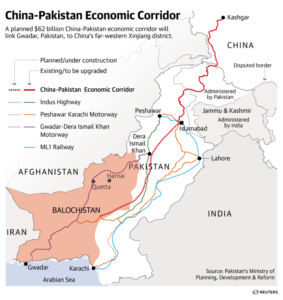 China’s plans to rule the seas hit trouble in Pakistan
China’s plans to rule the seas hit trouble in Pakistan
A strengthened Pakistan helps China outflank its old adversary for supremacy in Asia: India.
(Politico Eu) China’s strategic ambition to extend its maritime power across the Indian Ocean is hitting severe obstacles in the giant, volatile Pakistani province of Balochistan.
Beijing’s priority is to develop the sleepy Baloch fishing port of Gwadar, 300 miles west of Karachi, to project its commercial and naval influence further west. But kidnappings, drive-by shootings and bomb attacks in the past few weeks and months offer a chilling warning that China will have to pay a high price for a deep-water harbor near the mouth of the Persian Gulf.
For the Chinese, there are clear reasons to run the risks of investment in Balochistan, one of the world’s wildest frontier regions. Gwadar will be a critical addition to Beijing’s so-called string of pearls: a ring of ports around the Indian Ocean, including in Sri Lanka, Djibouti and the Seychelles, which are intended to outflank China’s nuclear-armed rival for supremacy in Asia: India.
For Pakistan, the nationwide CPEC investments are a vital component of national regeneration. Islamabad hopes that the boondocks of Gwadar will be transformed into an unlikely new Dubai, served by a slick new $250 million airport.
The scale of the Chinese investment, however, means Pakistan has to negotiate a domestic political minefield. Many in Balochistan feel aggrieved that they will never see any of the cash from Beijing, which would either be seized by the other provinces or would turn into profit back in China. It is these discontented Baloch who pose the most stubborn threat to China’s plans.
8 August
Thailand’s Kra canal plan would link Indian, Pacific oceans, benefiting China
(Sydney Morning Herald) A group of influential retired Thai generals, politicians, academics and businessmen with close links to China have revived plans to construct a US$28 billion ($35 billion) and 135 kilometre canal across southern Thailand to link the Indian and Pacific oceans.
Seen as an Asian equivalent of the Suez or Panama canals, the so-called Kra canal would save at least 1200 kilometres, or two to three days sailing time, for ships bypassing the narrow, traffic-choked and piracy-prone Malacca Strait, which links China, Japan and other Asian nations to the oil fields of the Middle East and markets in Europe, Africa and India.
The plan would be one of the most ambitious mega-projects ever undertaken in Asia that could be funded through China’s multi-billion dollar Belt and Road and New Maritime Silk Road initiatives, aimed at reshaping trade across Asia.
[Thailand’s prime minister, Prayuth Chan-ocha,] said in June he did not support the project because separating Thailand’s south could embolden Muslim-Malay separatists who have waged a bloody insurgency against the Thai state for more than a decade.
In May both China and Thailand denied media reports they had signed an agreement to build the canal which would also deprive Singapore of an estimated 30 per cent of its shipping trade, challenging the regional dominance of the city-state’s harbour.
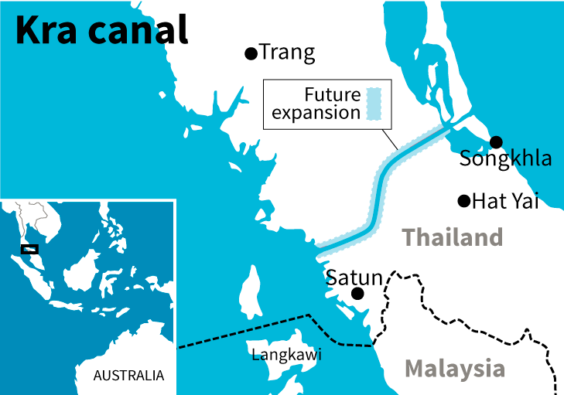
(Huff Post) After Suez and Panama, Time to Build the Kra Canal!
The Kra Canal: Double bypass
Recent reports that Thailand, with Chinese money, is planning to build a new canal between the Pacific and Indian Oceans have set off a new wave of alarm bells over China’s plans to dominate the region. If – and it is a big if – the project goes ahead, it will create some big winners and losers.
The project would involve carving a US$28 billion, 135km canal through the Thai isthmus between the Gulf of Thailand and the Andaman Sea, cutting some 1200km (or two to three days) off journeys between the Indian and Pacific Ocean. It would be the Asian equivalent of the Suez Canal or the Panama Canal, and would be substantially more difficult to build.
The idea has been around for a long time. A really long time. The British and French looked at it in the nineteenth century. They decided it was too hard, but the British still extracted a promise from the King of Siam that no-one else would be allowed to do it. In the 1930s, there was a scare about Japanese plans to build it, which would have allowed the Japanese fleet to bypass the British base at Singapore. Here’s a classic 1940 British newsreel that explains everything you need to know on the subject (including a real Samurai).
2 June
Kenya’s $3.2 billion Nairobi-Mombasa rail line opens with help from China
(Quartz) More than a 100 years ago, the British opened the “Lunatic Express,” a 600-mile railway running through Uganda and Kenya, to cement its colonial claims over rival European powers in East Africa. Today, Kenya has replaced that decrepit rail line with a new one, this time built by a new foreign power in the region.
The Standard Gauge Railway (SGR), built and funded by the Chinese, officially opened to the public on Madaraka Day, the anniversary of Kenya gaining the right of self-rule. In a ceremony attended by Kenyan and Chinese officials, a Kenyan orchestra performed Chinese patriotic songs underneath the gaze of a bronze statue of Zheng He, a Chinese admiral who led expeditions to Africa in the 15th century.
The $3.2 billion rail line, the first leg of which connects Kenya’s capital, Nairobi, and the port city of Mombasa, is the country’s largest infrastructure project since independence. Eventually it will extend to Uganda, Rwanda, South Sudan and Ethiopia, placing Kenya at the center of an East African rail network.
… the 470-kilometer (290 miles) rail line has come under criticism for its cost and burden on the country’s public finances—80% of it was funded through concessional loans from China, which already holds over half of Kenya’s external foreign debt. Environmentalists have protested the line’s interruption of Nairobi National Park. Some Kenyans have complained about lack of jobs it created for locals.
2015
22 October
At the U.N., Beijing Begins to Shift Away From Putin
Beijing and Moscow have long maintained a united front against the West. That’s changing as a rising China begins to chart its own course.
(Foreign Policy) China and Russia consider one another strategic partners and they strive to align their votes at the United Nations as closely as possible, in part to act as a brake on the projection of American power. But maintaining that partnership is exacting an increasing diplomatic cost for China as Russia has grown assertive in ways that have threatened the interests of Beijing’s commercial partners, from the Middle East to Ukraine.
A senior Security Council diplomat said Beijing and Moscow are still aligned on issues ranging from Iran to North Korea. But the diplomat said the alliance is weakening as the two countries find their priorities “diverging” on a range of issues, from South Sudan to Ukraine and Syria, where Beijing favors a more intensive diplomatic push to end the fighting between Syrian strongman Bashar al-Assad and his enemies.
China’s Xi seals nuclear power deal as part of £40 billion splurge in Britain
Cameron is pitching Britain as the pre-eminent Western gateway for investment from China, though the warmth of the reception for Xi has raised some eyebrows with allies and drawn criticism that London is ignoring China’s human rights record.
(Reuters) Chinese President Xi Jinping has sealed a multi-billion dollar deal to finance nuclear power stations in Britain, crowning a visit that Prime Minister David Cameron hopes will unleash a wave of investment from the world’s second largest economy.
After a day of pomp, Communist Party General Secretary Xi on Wednesday turned from pageantry to discussion of 40 billion pounds’ ($62 billion) worth of deals with Cameron in his Downing Street residence, where the landmark nuclear deal was signed.
In the first major Chinese investment in a Western nuclear facility, China’s General Nuclear Corporation (CGN) will take a one-third stake in the planned 18 billion-pound ($28 billion) Hinkley Point nuclear plant controlled by France’s EDF.
8 October
The domestic controversy over China’s foreign aid and the implications for Africa
(Brookings) During his visit to the United Nations just last month, Chinese President Xi Jinping made major pledges in foreign aid. This included $2 billion to the new South-South Cooperation Assistance Fund, debt forgiveness for least-developed countries, and $100 million in military assistance to the African Union, as well as a 10-year, $1 billion “peace and development” fund to support the United Nations.
Africa will foreseeably benefit greatly from the new packages: The continent has traditionally been a priority partner in China’s South-South cooperation plan; the debt forgiveness will potentially cover some least-developed African countries; and the military assistance will support the development of the African Standby Force and the African Crisis Response Force. Similarly, China’s contribution to the U.N. peacekeeping standby force, the committed deployment of a Chinese helicopter unit in Africa, and the funding to U.N. peacekeeping through the “peace and development” fund will have real impact in Africa for peacebuilding and conflict resolution.
China’s generous gesture is said to have “surprised” the U.N. and has been welcomed by developing countries and the development community. Such positivity is in sharp contrast to the widespread harsh criticisms within Chinese society over the new aid commitment. …
China’s foreign aid to developing countries, including those in Africa, is indeed un-altruistic. As a permanent member of the U.N. Security Council and a world power, China understands that it cannot miss out on the foreign aid scheme: Bilaterally, China has traditionally seen aid as a policy instrument to cement political friendships and facilitate China’s political agenda at multilateral forums. Xi himself has emphasized that China needs to focus on the political and strategic benefits rather than the narrow, immediate economic calculations. Economically, the “tied aid” that combines Chinese foreign aid, investment, and development assistance helps China promote Chinese exports and service contracts. …
The controversy of China’s foreign aid could also provide more momentum for China to adopt international norms and best practice, such as the separation of non-commercial capacity-building programs and commercially related “tied aid” programs. Pragmatic as China is, the country is unlikely to give up foreign aid as a political and economic policy instrument completely, although better practices can be expected. As China muddles through its competing foreign and domestic agendas, Africa should adeptly navigate the changing tides.
5 October
Nuclear space race picks up pace: China unveils rocket capable of firing 20 nukes to defeat US missile shield
Successful debut of the Long March 6 puts President Xi Jinping in a better bargaining position with Washington on security, experts say
“The launch of the Long March 6 will definitely help President Xi Jinping increase his bargaining power on security issues when dealing with US President Barack Obama,” said defence policy specialist He Qisong of the Shanghai University of Political Science and Law.
“The launch will send a message to the US that the PLA now is capable of breaking its ballistic missile defence system in Asia, because … the multipayload technology can also be used on the DF-41 [long-range nuclear missile].”
20 April
C Uday Bhaskar: Is Xi’s Visit to Pakistan the Beginning of a Lasting Friendship?
The core objective will be to advance Xi’s ambitious vision of a land and maritime connectivity project (the Belt and Road Initiative – BRI) that will link the Pakistani port of Gwadar to Kashgar in western China.
Can China realize this tantalizing objective given the domestic political contestation and related internal turbulence that envelops the Pakistan- Baluchistan-Xinjiang region?
19 January
Patrick Brown: Orient express, China’s grand plan for a New Silk Road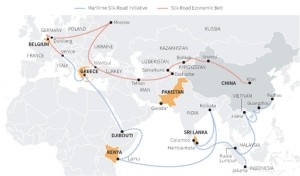
(CBC Analysis) High-speed trains, high-tech ports, China’s new trade network is vast, fast and hugely ambitious
Since coming to office two years ago, President Xi Jinping, who went to Maldives in September, and Premier Li Keqiang, who visited Kazakhstan and Serbia last month, have between them travelled to more than 50 countries.
Apart from the obligatory pilgrimages to summits with great powers, almost all the places they’ve visited have been linked to the grandiose master plan for the New Silk Road and the New Maritime Silk Road.
In the process, the traditional tools of Chinese diplomacy — offers of a panda here or a football stadium there — have given way to colossal sums of money, manpower and expertise for local infrastructure.
After decades of hurtling construction and development at home, China is now planning, funding, building, or helping to build, a vast network of roads, railways, tunnels, bridges, pipelines and ports across Asia and Europe.
Chinese maps of the project show land routes snaking across Central Asia into Turkey and up through Europe as far as Rotterdam.
The sea route goes from southern China with waypoints in Southeast Asia, Sri Lanka, Maldives, India and Kenya, then on through the Suez Canal to join with land routes at a port in Greece.
On land and sea, spurs spread out like tentacles from the main route to places like Indonesia, Afghanistan, Iran and even Venice, a historical nod to the home of Marco Polo.
2014
28 November
Commentary from Nick’s Gleanings
— one must wonder whether China is not a giant with feet of clay (Daniel 2 : 31-33)6. For it has a rapidly aging population & a rising dependency ratio that will become a ‘boat anchor’ on its GDP growth potential, contributing to it sinking well below the 7% level that by Beijing’s own estimate is the ‘red line’ below which the risk of social unrest escalates7. It has a banking sector in which for years more problems have been swept under the rug than a non-Alberta dog has fleas & a real estate market that is hugely overbuilt & increasingly seems like an accident looking for a place to happen. It has a rapidly growing middle class whose conspicuous spending habits accentuate the growing income polarization that will lead to social unrest, and which is increasingly feeling its oats & becoming more vocal about the fact that their health, & that of their ‘Little Emperor’ singleton offspring, is being endangered by having to breath air-, drink water-, & eat food that is not really fit to breathe, drink or eat, many of whom aspire to live abroad & have been shifting their capital out of the country at a great rate. And Premier Li’s efforts to shift the country’s economic model from being export-, to domestic consumption-, driven, coincident with President Xi’s War on Corruption, risks creating stresses within the ruling class that may endanger the political system’s survival, especially in a country that historically was hallmarked by warlords & fiefdoms, in which Beijing’s control over the regions is anything but absolute and in which the only glue holding it together is the Communist Party. And last, but not least, Beijing’s blatant territorial ambitions have started to engender pushback among its neighbours, none of whom are big enough to do so effectively by themselves, but could represent a real threat to Beijing’s dreams if self-preservation were to make them join forces..
— A report last week by IHS Jane’s Defense revealed new details about a land reclamation project by China on the Fiery Cross Reef in the Spratly Islands (which China in three months has turned into an island by dredging soil, sand & coral from the sea around it and dumping it on top of the reef). It said that it is now 9842 feet (approx. 3,000 metres) long & one-tenth that wide, i.e. long enough to accommodate, in due course, a landing strip, and that it has a harbour site big enough to handle tankers & war ships. This prompted a US military spokesman, Lt-Col. Jeffrey Pool, to call on Beijing (& the other governments in the region with territorial claims on the Spratlys, i.e. Philippines, Vietnam, Malaysia, Brunei & Taiwan) to cease such all such activities. This prompted PLA Maj-Gen. Luo Yuan in an interview with the state-run Global Times to tell the US in effect to butt out, saying the project was “completely legitimate and justifiable” (which it isn’t under current international cum maritime law) and that “the US is obviously biased considering that the Philippines, Malaysia, Vietnam have already set up military facilities” on other nearby reefs and have occupied some of the islands. This was followed up by an editorial in the same paper claiming China was building on the reef “mainly to improve the living standardsof the reef-stationed soldiers8 … China’s construction on the Yongshu Reef (their name for it) will not be affected by US words … The Yongshu Reef is becoming a big island, which shows China’s prominent construction capabilities.” Nick adds:
The East China Sea at some point will become a flash point in which America’s mettle will be tested & the existing world order challenged. For while Beijing claims almost all of it as an ‘inland sea’, under existing international & maritime law it doesn’t have a leg to stand on; for the islands are 580 miles from the nearest Chinese landfall on Hainan Island, twice or more their distance from the Philippines & Vietnam.
13 November
China-Japan Relations: Abe And Xi APEC Meeting Only Symbolic
(International Business Times) For the first time in more than two years, China and Japan’s top leaders shared a symbolic handshake at the Asia Pacific Economic Cooperation summit in Beijing earlier this week. The meeting between Japan’s Shinzo Abe and China’s Xi Jinping was described by various news outlets as “uneasy,” “awkward,” but was also considered to be an important “icebreaker” in what are otherwise icy relations between the East Asian nations.
China and ASEAN: Moving Beyond the South China Sea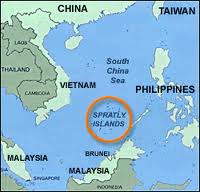
China needs to try different tactics on the South China Sea disputes to gain ASEAN’s support for other Chinese projects.
The APEC summit provided a platform for China to display its vision for the Asia-Pacific: an integrated economic community where Chinese growth is the major driver for prosperity (and thus Chinese interests must be respected). Ironically, however, China may face the most resistance toward its “Asia-Pacific Dream” from its immediate neighbors – particularly ASEAN members that have testy territorial disputes with China.
Reuters reports that the South China Sea issue is likely to be a major topic of discussion at the various ASEAN summits, much to China’s chagrin. Beijing prefers to handle these issues bilaterally, rather than through larger, multilateral bodies. ASEAN secretary-general Le Luong Minh expressed concern over “a widening gap between the political commitments and the actual actions, the real situation at sea.” Even non-claimants are concerned that the tensions are dangerous – Singapore’s foreign affairs minister K Shanmugam said the disputes are one of the biggest threats to regional security, Reuters said.
The Beijing APEC Summit in Review
David Shambaugh on China’s ultimate goals in the region and how the APEC summit outlined this ‘Asia-Pacific dream.’
(The Diplomat) The Asia-Pacific Economic Cooperation (APEC) leader’s meeting was held in Beijing this year, giving China the perfect opportunity to outline its own vision for the Asia-Pacific region. Dr. David Shambaugh, professor of public policy and international affairs and director of the China Policy Program at George Washington University, sits down with The Diplomat to discuss China’s ultimate goals in the region and how the APEC summit outlined this “Asia-Pacific dream.”
China offers ASEAN friendship, loans as South China Sea tension bubbles
(Reuters) – China’s Prime Minister Li Keqiang proposed a friendship treaty with Southeast Asian countries and offered $20 billion in loans on Thursday but held firm on the line that Beijing will only settle South China Sea disputes directly with other claimants.
China, Taiwan and four members of the Association of Southeast Asian Nations (ASEAN) have competing claims in the sea where concern is growing of an escalation in disputes.
“China … stands ready to become the first dialogue partner to sign with ASEAN a treaty of friendship and cooperation,” Li told leaders at an East Asian summit in Myanmar.
14 October
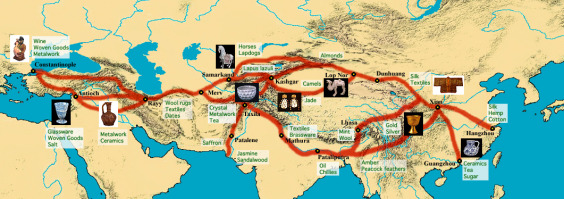 Shashi Tharoor: China’s Silk Road Revival
Shashi Tharoor: China’s Silk Road Revival
(Project Syndicate) The phrase “Silk Road” evokes a romantic image – half history, half myth – of tented camel caravans winding their way across the trackless deserts and mountains of Central Asia. But the Silk Road is not just part of a fabled past; it is an important feature of China’s current foreign policy.
In September of last year, in a speech at Kazakhstan’s Nazarbayev University, [President Xi Jinping] announced the so-called “Silk Road Economic Belt,” a new foreign-policy initiative aimed at boosting international cooperation and joint development throughout Eurasia. To guide the effort, Xi identified five specific goals: strengthening economic collaboration, improving road connectivity, promoting trade and investment, facilitating currency conversion, and bolstering people-to-people exchanges.
Xi has emphasized that the goal of the Silk Road economic initiative is to revive ancient ties of friendship in the contemporary globalized world. But he undoubtedly has a domestic motive as well, rooted in the growing prosperity gap between eastern and western China.
15 May
China rides to Russia’s rescue with investment plan
(Emerging Markets) The decision by a joint venture between Russia and China to invest up to $2bn in key infrastructure projects will relieve the pressure on the Russian government to attract funds to offset the massive flight of capital
15 April
Why Ukraine crisis has China in a bind
By Christopher S. Chivvis, senior political scientist at the RAND Corporation and expert in European and Eurasian security issues, and Bonny Lin, an associate political scientist at RAND and an expert on Asia-Pacific security issues.
The Chinese view of the crisis does suggest … that China’s growing role in the world, grounded in globalization, will encourage it to avoid playing a destabilizing role as the crisis evolves. A refusal by China to back Russia on Crimea may not be a de facto backing of the U.S. position, but it might help discourage Russia from further aggression.
(Global Public Square) At Sunday night’s emergency U.N. Security Council meeting, Western countries denounced Russian efforts to destabilize eastern Ukraine. Depending on your reading of its statement, China either refused to do the same, or refused to back Russia. Either way, the meeting was just the latest example of how the Ukraine crisis has put China in a bind.
Russia’s claim that it will seek a closer relationship with China in the event the West isolates it is likely to continue to meet with a very cautious response from Beijing. As much as China may wish to lean on Russia should Beijing find itself at odds with the United States, Xi seeks a new type of great power relationship with the United States that calls for mutual respect, no confrontation, and cooperation. China wants – and some even argue needs – to have good relations with the United States and the international community as it continues to grow. The United States and the European Union are also China’s largest trade partners. An embrace of Russia at this time could cost China much global goodwill.
Finally, China does have a relationship with Ukraine that is not irrelevant. It had strong ties on trade, agricultural partnerships, and the military, and will want to see those ties endure under the new Ukrainian government. Xi has also made combating corruption a key domestic agenda. Given that cronyism was a key factor in Yanukovych’s demise, it would not be easy for Xi to appear to side with him without negative domestic blowback.
If China hesitates to tilt toward Russia on Crimea, this will not, of course, be a sign that it is ready to join the West in a full condemnation of Russian policy, much less support harsh sanctions or military measures. Even if Russia invades Ukraine proper, Beijing may hesitate to publicly denounce Russia and prefer to sit on the sidelines, as it did in the 2008 Russia-Georgia war. Chinese strategists will question whether Beijing has the leverage needed to convince Putin to change course. In general, China has little appetite for entanglement in conflict far from its borders, especially given multiple challenges in its own neighborhood.
21 March
Interactive: China’s African spending spree
(Al Jazeera) Take a tour of the dams, stadiums, mines and super-highways financed, sometimes controversially, by Beijing.
From dams to super-highways, from mining sites to research centres, from the African Union headquarters to stadiums and railways, China boasts a strong and growing presence in Africa.
Analysts see these projects as a bid by China to increase its soft power across the resource-rich continent. Chinese interest is reciprocated by many governments in Africa, which welcome the inflow of capital – and appreciate the fact that, unlike many Western governments, China does not urge them to respect human rights or foster democratic systems.
But China’s growing influence has alienated some in Africa as well, who resent what they describe as a form of economic colonialism and decry Chinese companies’ treatment of local workers.
10 January
(BBC) China and Japan are criticising each other’s policies in Africa as each country pledges more money for the continent.
Japan has suggested China is buying off African leaders with lavish gifts.
Meanwhile China accuses Japan of courting African support for a place on the United National Security Council. …
China has hailed Africa a “golden ground” for foreign investment and has pledged to double its aid to the continent to $20bn a year. …
The Chinese often pay for public buildings, including the African Union headquarters in Ethiopia, where Mr Abe is due to speak on Tuesday.
Mr Taniguchi said: “Japan’s aid policy is to really aid the human capital of Africa.” He said many African leaders believed that through strong links with Japan they could obtain industrial expertise and know-how.
China insists its aid and co-operation with Africa are completely selfless. … Chinese foreign ministers are visiting East and West Africa this month
2013
9 December
Ian Bremmer: China’s air zone announcement was just the beginning
The air zone declaration and its aftermath make it clear that China intends for its security position to win out in the East China Sea, and expects it to be a faster process, given the shift of the regional security and economic power balance in its favor.
(Reuters) When China announced its decision to claim a wider air zone that encompassed the disputed Senkaku/Diaoyu Island territories, the East China Sea erupted into conflict reminiscent of the Cold War era. In response, the United States and Japan declared the zone illegitimate and flew military aircraft through it, while China deployed fighter jets to identify them.
But this was not a simple instance of China overstepping and getting burned — nor was it as sudden and unexpected as headlines suggest. Rather, it was the manifestation of a longstanding Chinese regional strategy that is only just beginning. And China is likely quite pleased with how it is playing out thus far.
For years, China has been looking for opportune moments to test the existing status quo of regional security, and then advance its self-interests.
23 October
China, India sign deal aimed at soothing Himalayan tension
(Reuters) – China and India signed a deal on Wednesday aimed at soothing tension on their contested border, as the two nuclear-armed giants try to break a decades-old stalemate on overlapping claims to long remote stretches of the Himalayas.
In 1996 China, Kazakhstan, Kyrgyzstan, Russia & Tajikstan, meeting in Shanghai agreed to “deepen military trust in border regions”. One year later this resulted in a “Treaty on Reducing Military Forces in Border Regions”. When Uzbekistan joined them in 2001 it became known as the Shanghai Cooperation Organization (SCO), leading, one year later, to a bilateral Russia-China “Treaty of Good-Neighbourliness and Friendly Cooperation” (which was what it had been all about from the outset since these two share a long, largely indefensible, & occasionally fought-over, border, and Moscow had, & still has, concerns about China’s growing influence in Eastern Siberia & the four ‘minion countries’ about becoming sandwiched in any future military clash between them). Four other countries (Afghanistan, India, Mongolia & Pakistan) have observer status (deemed indicative of intent to become, at some point, a full member – the US apparently sought such status in 2006 but was turned down but if India were ever to become a full member this would be greatly boost the group’s geopolitical status), recently the number of countries with “dialogue partner” status went from two (Belaurus & Sri Lanka) to three when Turkey joined them, & three entities (ASEAN, CIS & Turkmenistan) have “guest attendant” status, while SCO itself has observer status at the UN, the EU, ASEAN, CIS & the Organization of Islamic Cooperation. Its six members account for 60% of Eurasia’s landmass & 25% of the world’s population (the latter of which would double if the four observer nations were included), but account for just 14% of global GDP for the six & 17% for the ten. (Nick’s Gleanings #530 September 2013)
Is China Losing the Diplomatic Plot?
Kishore Mahbubani
(Project Syndicate) In 2016, China’s share of the global economy will be larger than America’s in purchasing-price-parity terms. This is an earth-shaking development; in 1980, when the United States accounted for 25% of world output, China’s share of the global economy was only 2.2%. And yet, after 30 years of geopolitical competence, the Chinese seem to be on the verge of losing it just when they need it most.
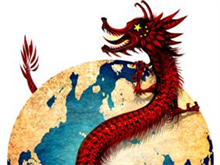
China’s leaders would be naïve and foolish to bank on their country’s peaceful and quiet rise to global preeminence. At some point, America will awaken from its geopolitical slumber; there are already signs that it has opened one eye.
But China has begun to make serious mistakes …
The “nine-dotted line” that China has drawn over the South China Sea may prove to be nothing but a big geopolitical millstone around China’s neck. It was unwise to attach the map in a note verbale responding to a joint submission by Vietnam and Malaysia to the United Nations Commission on the Limits of the Continental Shelf in May 2009. This was the first time that China had included the map in an official communication to the UN, and it caused great concern among some ASEAN members.
The geopolitical opportunity implied by inclusion of the map has not been lost on America, which is why the US, somewhat unusually, has made another effort to ratify the Law of the Sea Convention. Having tabled the nine-dotted line at the UN, China walked into a no-win situation, owing to the difficulty of defending the map under international law. Indeed, as the eminent historian Wang Gungwu has pointed out, the first maps to claim the South China Sea were Japanese, and were inherited by Nationalist China. (July 26,2012)
*******************
12 June
Ghana Gold Mines Suggest Larger Crisis for China
Export of ‘China model’ will encounter more and stiffer resistance
(Epoch Times) A recent announcement by Chinese officials that Ghana will release Chinese citizens detained for illegal gold mining and grant them a safe return to China seemed to end that crisis. In fact, Chinese are still in hiding, the issue of illegal gold mining by Chinese in Ghana has not been resolved, and tensions continue to increase between China and African countries with heavy Chinese investments, interest, and influence. …
Individual illegal miners are hardly the only problems involving China in Africa.
In Ghana, six large Chinese companies legally mine gold there. In other African countries, more Chinese state-owned companies work on oil fields, construction sites, and in other enterprises.
These large Chinese companies have been accused of abusing labor rights and causing environmental damage.
Chinese companies and individuals, legal or illegal, are not intentionally doing this to African countries. They have been doing things this way in China for several decades. They actually don’t know any other way.
7 May
China-Africa joint medical research to deepen
(SciDev.net) China will deepen joint medical research with Africa, particularly in training African medical scientists.
Ren Minghui, director-general of the Department for International Cooperation within the National Health and Family Planning Commission of China, said research and development is one priority area of collaboration being explored.
“China can support Africa in technical areas of research such as having scientists train in institutions such as the Chinese Center for Disease Control and Prevention, one of the most important institutes in China for research in preventive diseases,” he told SciDev.Net at the Fourth International Roundtable on China-Africa Health Cooperation in Botswana, which ended today (7 May).
25 April
China’s second largest law firm opens Israel office
A Chinese law firm with international operations is launching official activity in Israel opening a local office. Earlier this month, the giant Chinese law firm, Yingke, the second largest in China, launched operations in Israel. The firm merged with Israeli law office Eyal Khayat Zolty, Neiger & Co. In fact, Yingke acquired the firm’s activities in order to open an office in Israel.
With over 2,000 lawyers in 36 offices located on four continents, the merged firm’s office in Israel will now be called Yingke Israel – Eyal Khayat Zolty, Neiger & Co.
“We and our Chinese partners view our relationship with Yingke as an important and complementary step in the international activity of our offices,” said partner Eyal Khayat (52), who specializes in advising companies on commercial and high-tech issues. “The Chinese examined various options in Israel, and in the end we were selected due to our relative advantages that set us apart from the other contenders for a merger. The Chinese believed our prominence in the various areas of high-tech, venture capital and the government sector to be important.”[emphasis added]
11 April
China’s maturing relationship with Africa
(The Economist Chief Economist) It is no secret that economic links between Africa and China continue to deepen, but as China’s footprint on the continent expands—and as its African hosts’ response to the Chinese presence evolves—new opportunities will emerge. Commodities are still an important part of the picture, but we have identified a number of other potentially fertile areas of co-operation. Tourism is one; Africa is attracting an increasing number of Chinese tourists. Offshoring also offers considerable potential, as manufacturing becomes costlier in China. Importantly for these and other business opportunities, both sides seem to be managing the politics of their burgeoning relationship in more constructive fashion.
25 March
Chinese trade cuts both ways for Africa
(Financial Times) Developing countries perform a balancing act with the world’s second-largest economy as influx of businesses brings both investment and competition
China reaches out to UN, promising stronger ties
Chinese President Xi Jinping today told UN Secretary-General Ban Ki-moon that his country will increase support for the United Nations. Xi says China backs UN efforts on creating peace and fostering development in Africa and elsewhere. People’s Daily (China) (3/21)
16 March
Dr. Jyoti Prasad Das — India’s Northeast: In the Chessboard of Geopolitics
(Foreign Policy Journal) China seeks territorial gains from India in 3 Himalayan sectors; Eastern (Asaphia sector of Arunachal and the Fingers Area of northern Sikkim), Central (Bara Hoti sector of Himachal), and Western (Trig Heights and Demchok area of eastern Ladakh).
China is on course to becoming a global power. Until China attains that status, it would not risk losing what it has gained, as any prosperous nation becomes wary of losing what it has. The next onslaught on India would inexorably escalate into a no-holds barred conflict. China’s actions would polarize world opinion against it, and Beijing would be hard pressed to legitimize its actions. China is bogged down with maritime disputes in the South China Sea and challenged by the US’s pivot policy. It will not militarize the border dispute with India anytime soon. Beijing has shown a willingness in building military-to-military relations featuring lasting stability and friendly co-operation. Both sides are set to resume the ‘Hand in Hand’ joint military exercise this year. The Chinese Development Bank has stepped in to invest in Indian companies to offset some of the trade deficit that India is facing. China’s main intention is to prevent India from becoming a combative regional power. Denial of Chinese visas to Indian citizens of Arunachal, border transgressions, and blocking ADB loans for development projects in Arunachal are attempts to raise the stakes of India’s sovereignty on Arunachal, which China calls southern Tibet.
What is unnerving for India is China’s plans to build dams in the upper reaches of the Brahmaputra, which could be convulsive for the NER.
7 February
Westward Ho! As America pivots east, China marches in the other direction.
(Foreign Policy) In November, Barack Obama became the first sitting U.S. president to visit Burma, and the first to visit Cambodia. As part of his administration’s pivot to Asia, Obama has ratcheted up his diplomacy with the region. Besides Southeast Asia, which is moving closer to the United States at the cost of its relationship with China, Obama has also re-emphasized his security relationship with China’s rival Japan. But as the United States pivots out of the Middle East and Afghanistan and into East Asia, Beijing is debating a pivot of its own: a grand strategic proposal to shift its attention from East Asia and rebalance its geographical priority westward to Central Asia, South Asia, and the Middle East.
The strategy, called “Marching West,” was recently articulated by Wang Jisi, dean of the School of International Studies at Peking University and one of China’s most important strategic thinkers, in an October article in the Global Times newspaper. The proposal has passed the stage of academic research, and the front-runners of Beijing’s foreign-policy apparatus have been mobilized to study feasibility, implementation, and potential reactions. The Chinese Academy of Social Sciences, China’s most prominent think tank, will be holding an internal conference to study Marching West, according to a Beijing-based scholar. Meanwhile, the U.S. Embassy in Beijing is quietly investigating Marching West, according to several people who spoke with U.S. officials about the strategy.
2012
30 July
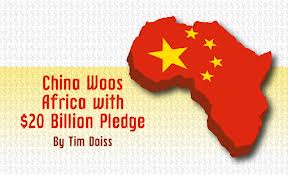 China Woos Africa with $20 Billion Pledge
China Woos Africa with $20 Billion Pledge
China and Africa solidified their ties last week at the fifth Forum on Chinese-Africa Cooperation (FOCAC) in Beijing. Once again China offered money, this time sweetening the pot by almost doubling the aid from last year’s forum. Chinese President Hu Jintao pledged $20 billion in aid to African countries. According to Hu, the funds will be allocated to aid Africa with infrastructure and agriculture.
Not that this is anything new. China’s African romance can be summed up in one word: Hydrocarbons. For instance, on Thursday July 18 and in town for the forum, Niger’s President Mahamadou Issoufou visited CNPC. According to a CNPC press release President Issoufou had “a friendly talk with Mr. Zhou Jiping [Vice Chairman and President of PetroChina and General Manager of CNPC] on promoting oil and gas cooperation.” Issoufou praised China, attributing cooperation agreements with CNPC for turning Niger into an oil producer and one that can now “boast its own refinery.”
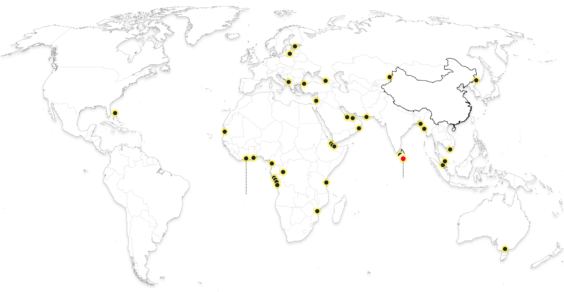 Note: China provided only partial financing for some ports. | Sources: Construction Intelligence Center; Johns Hopkins University School of Advanced International Studies; Center for Strategic and International Studies; New York Times reporting.
Note: China provided only partial financing for some ports. | Sources: Construction Intelligence Center; Johns Hopkins University School of Advanced International Studies; Center for Strategic and International Studies; New York Times reporting.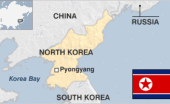

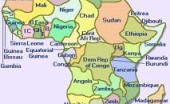
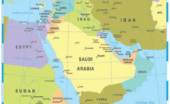
2 Comments on "China geopolitical strategy"
I know this is really boring and you are skipping to the next comment, but I just wanted to throw you a big thanks – you cleared up some things for me!